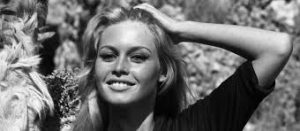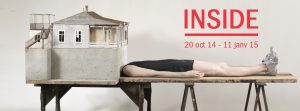Relative to other small islands, St Barts has a great selection of art; however, Paris is a veritable oasis with its eclectic range of art spanning the centuries. I thus made the most of my time in this ‘art Mecca’, visiting the many galleries in and around Rue de la Seine, as well as exhibitions in the various musées d’art. I started with the permanent collection in the Musée d’Orsay, which happened to fall on the first Sunday of the month, meaning that entrance was free. I was rather hesitant fearing I would have to fight the crowds, but the first chilly signs of autumn had limited the numbers. No matter how many times I visit this immense glass-topped gallery, I will never fail to be impressed by the beautiful architecture of this former railway station, Gare d’Orsay, complete with its monumental station clock. I’m equally captivated by its vast collection (the largest in the world) of impressionist and post-impressionist masterpieces, especially Degas’ bronze ballerina – so elegantly poised with her silk hair ribbon and gauze skirt.
 |
||||
| Musée d’Orsay |
Impressionism is also the theme of the Musée Marmottan Monet, which houses the largest collection of impressionist and post-impressionist works by Claude Monet, as well as works by his impressionist contemporaries (Degas, Manet, Pissarro, Gauguin, Renoir et al). This former hunting lodge, on the edge of the Bois de Boulogne, was originally owned by the Duke of Valmy and later sold to the Marmottan family. This wonderful collection of masterpieces is rather like a hidden secret, tucked away in this gentrified home in the 16th arrondissement – a most tranquil setting for a museum. I was lucky enough to see the exhibition of Monet’s famous ‘Impression, soleil levant’ – depicting the port of his home town Le Havre – which in fact gave rise to the name of the impressionist movement.
It was interesting to see the newly refurbished Picasso museum after a five year closure, which fortuitously reopened on October 25th, whilst I was in Paris. I was able to compare and contrast the museum to my previous visit in 2009 for ‘Cubisme avec Picasso et Braque’. The interior of this beautiful building, Hôtel Salé, is now a simplified modern exhibition space, and twice its former size. To maximise hanging space, signboards have been replaced with a free guidebook (very smart and informative, but not particularly ‘green’), which directs the visitor through Picasso’s works, spanning his entire career from 1895-1972. Organised chronologically and thematically, these paintings and sculptures are displayed on three floors, or rather five if you include basement ‘studios’ and Picasso’s personal collection in the ‘loft’. You thus need to set aside a good couple of hours to study, admire and fully appreciate Picasso’s extensive repertoire. In fact, to fully appreciate these works of art, it would be best viewed on two/three separate occasions, as I felt rather ‘Picasso punch drunk’ at the end of the exhibit – less would certainly have been more.
 |
||||
| Musée Picasso |
Relatively speaking, ‘Dali fait le mur’ was a mere snapshot of an exhibition, housed in the dark basement of the Salvidor Dali museum (Espace Dali) in Montmartre. It was a fascinating exhibition featuring Dali-inspired works of art by twenty-two street artists, who ‘dared to challenge the surrealist universe with the vocabulary and code of suburban art … ’ My favourite was a very vibrant painting by Arnaud Rabier Nowart, which initially caught my eye in the Metro, publicising the exhibit. Arnaud RW’s work cleverly portrayed urban art at the Espace Dali with an image of the museum and Sacré Coeur in the background; the wall of the museum was covered in multi-coloured graffiti depicting Dali’s face. Coincidentally, after the exhibition, when strolling through the not so attractive litter-strewn streets of Montmartre, I stumbled across the remnants of a huge market with marketeers busily re-loading their white market vans; I soon noticed that these market vans were adorned with none other than graffiti-style art. To top it all, as I turned down a side street, I discovered a group of graffiti artists adeptly using their aerosol cans to decorate the huge blank canvas of yet another market van – these talented individuals were evidently ‘challenging the surrealist universe’.
 |
| Espace Dali |
My glamorous Parisian friend and I joined a long line of equally elegant Parisian ladies, all patiently waiting to see the last day of ‘Les Années 50; La mode en France 1947 -1957’ at the Palais Galliera (Musée de la Mode de la Ville de Paris). It was early November, but the unseasonably warm temperatures and bright sunshine made queueing a painless and, what turned out to be, worthwhile experience. The exhibition displayed the rise of fashion in France during the 50s – the re-feminisation of style after World War II, whereby the shapeless soldier-look was replaced by designs to emphasise womanly curves. The newly established fashion house, Christian Dior, caused a ‘positive scandal’ by promoting the famous hourglass figure of this era. It was an important time for French haute couture, when a host of fashion houses became part of France’s national heritage, namely Chanel, Givenchy, Balenciaga, Pierre Cardin, to name but a few. Their beautiful designs were in the spotlight at the Palais Galliera – from daywear to evening wear, along with beachwear, country attire and lingerie. For France, this period marked a golden age of haute couture (including the introduction of prêt-à-porter), which subsequently became a key sector of the economy. At the same time, Paris regained its title as the world capital of fashion – a title that continues to this day and clearly evident at this exhibition, where the visitors were as glamorous as its mannequins.
 |
| Les Années 50 |
An icon of this French fashion world is Brigitte Bardot, who celebrated her 80th birthday on 28th September 2014. This was marked by a photographic exhibition at the Galérie de l’Europe on Rue de la Seine, featuring many undisclosed photographs by her close friend Sveeva Vigeveno, covering the decade 1967-77. This was a fascinating collection of photographs emphasising Brigitte’s alluring natural good looks, and it was easy to see how she became France’s emblem of style and beauty.
Natural beauty is also the focus of another photographer, Peter Lindbergh, whose exhibition of black and white photographs at the Gagosian Gallery exemplified his ‘elemental photographic language’ supporting his belief that real beauty cannot exist without truth. He feels that his subject’s expressiveness and movement are more important than clothing and setting, which was noticeably portrayed by his image of six emerging models in the late eighties (who later became renowned supermodels), wearing identical men’s white shirts. Once again, simplicity proves that less is more, even in terms of aesthetics when the truth always shines through.
 |
| Peter Lindbergh |
Nothing could be more truthful than the exhibition entitled ‘Inside’ at the Palais de Tokyo, which was intended to be ‘a voyage within, an exploration of self, and a unique experience that turns the building into an organism to be travelled’. Elaborate installations, often dominating a whole room, were used as a means of expression by the individual artists. I spent time reading the information on each exhibit, to better understand what was going through the artist’s mind and the message being conveyed. I felt the principle focus was the norms of society, norms that we have been conditioned to accept without questioning – routine, judgement, expectation, duty, pressure, money, success, beauty – all demands to which members of society blindly acquiesce, whilst suppressing their true thoughts, to the point where they don’t know who they are or what they truly think or feel. It was certainly most thought-provoking, albeit somewhat macabre, so not an exhibit to lift one’s spirits.
On a brighter note, both in colour and theme, was the more positive exhibition
‘Hybridization by Alexis Tricoire’ at Le Jardin des Plantes, which had a more optimistic view of the modern world. This artist intermingled industrialised products with nature, namely brightly coloured brushes that were in fact factory rejects. He transformed these brushes into ‘hybrids’ – vibrant lilies, creeping lianas, orchids and cacti. These industrial products thus lost their original functional identity, being transformed into works of art in a natural habitat that was both surreal and unpredictable. The visitor was invited to reflect upon the relationship between things that are natural and those that are artificial. The exhibition also brought awareness to recycling as a means of protecting our primary forests. ‘Hybridization’ was part of ‘Paris Design Week’, so was widely publicised and hopefully made people think more about the planet and how man’s creativity should respect and protect our natural world.
 |
| Hybridization at Le Jardin des Plantes |



